24 February 2023: Clinical Research
Effects of Nursing Care Using a Fast-Track Surgery Approach in 49 Patients with Early-Stage Hepatocellular Carcinoma Undergoing First-Line Treatment with Radiofrequency Ablation: A Retrospective Study
Shuqi Zhang1ABDE, Yanting Yang1BD, Wen Liu1AC, Bijin Yuan1CD, Chunyan Tao1AB, Guangjian Dou1ACEFG*DOI: 10.12659/MSM.939044
Med Sci Monit 2023; 29:e939044
Abstract
BACKGROUND: Fast-track surgery (FTS), also known as enhanced recovery after surgery (ERAS), includes a coordinated perioperative approach to patient care that aims to facilitate postoperative recovery. The role of nursing care is central to the concept of FTS. This retrospective study aimed to evaluate the effects of nursing care using an FTS approach in 49 patients with early-stage hepatocellular carcinoma (HCC) undergoing first-line treatment with radiofrequency ablation (RFA).
MATERIAL AND METHODS: A retrospective analysis was made of 49 patients with early-stage hepatocellular carcinoma who underwent first-line treatment with radiofrequency ablation in the Department of Hepatobiliary Surgery in our hospital from January 2020 to December 2021. The nurses have been nursing the patients in accordance with the requirements of FTS from 2021. Compared with the data of patients receiving traditional nursing, the detailed differences in postoperative recovery, pain score, complication rate, liver and kidney function, and nursing satisfaction were analyzed.
RESULTS: After applying the FTS nursing model, the patients had significantly shorter time to first flatus, infusion, postoperative hospital stay, and lower total hospitalization expenses (P<0.05). Moreover, the Numerical Pain Rating Scale score was lower than that in the control group, the postoperative complications in the 2021 group were lower than those in the 2020 group, and the nursing satisfaction was also better than that of the 2020 group (P<0.05).
CONCLUSIONS: Nursing care using a fast-track surgery approach with early-stage hepatocellular carcinoma patients undergoing first-line treatment with radiofrequency ablation is better than conventional nursing, and improves recovery of patients.
Keywords: Enhanced Recovery After Surgery, Liver Neoplasms, Nursing Methodology Research, radiofrequency ablation, Humans, Carcinoma, Hepatocellular, Length of Stay, Postoperative Complications, Nursing Care, Pain, Treatment Outcome
Background
Since the Danish surgeon Kehlet proposed the concept of fast-track surgery (FTS) in 2001, it has been gradually developed around the world, combined with the multidisciplinary progress in anesthesiology, minimally invasive surgery, and nursing technology in recent years [1]. The basic tenet of FTS is to treat the patient’s disease by minimal disturbance of their physiology. The protocol encompasses preoperative, intraoperative, and postoperative interventions, which when carried out together show maximal benefits [2].
Hepatocellular carcinoma (HCC) is one of the most common malignant tumors treated in clinical practice. In recent years, the incidence rate has been increasing yearly, ranking sixth in the global tumor incidence rate and the fourth in the global tumor mortality rate [3], which seriously threatens people’s lives and health.
Radiofrequency ablation (RFA) is a safe, minimally invasive, and efficient new surgical method. It uses electric current to make ions in cancer tissue oscillate at high speed and generate local high temperature to cause coagulation necrosis of cancer tissue. RFA is accepted as the best therapeutic choice for patients with early-stage hepatocellular carcinoma when liver transplantation or surgical resection are not suitable options according to the Cardiovascular and Interventional Radiological Society of Europe [4], nd it has been widely used in patients with liver cancer [5]. Many previous studies have shown the advantages of rapid rehabilitation surgery in hepatobiliary surgery [6,7]. However, its application in radiofrequency ablation is rarely reported. Therefore, this retrospective study aimed to evaluate the effects of nursing care using an FTS approach in 49 patients with early-stage hepatocellular carcinoma (HCC) undergoing first-line treatment with radiofrequency ablation (RFA).
Material and Methods
GENERAL INFORMATION:
There were 49 HCC patients diagnosed as hepatocellular carcinoma by pathological or imaging examination, which was in line with surgical indications of ablative therapy. Of these, 24 patients were in the 2020 group, including 19 males and 5 females, aged 52–80 years, with an average of (64.4±9.3) years. Liver function Child grading: Grade A 18 cases, grade B 6 cases. In the 2021 group, 25 patients were enrolled, including 20 males and 5 females, aged 47–87 years, with an average age of (63.8±10.1) years. Liver function Child grading: 19 cases of grade A, 6 cases of grade B. There were no significant differences in age, sex, liver function Child grade, or other general data between the 2 groups (
MEASURES:
The concept of fast tract surgery was introduced in our hospital January 2021, and the department has taken care of patients in accordance with the requirements of rapid rehabilitation surgery. Since FTS has been widely shown to benefit patients in many other departments, we regard this model of care positively [8,9].
Patients in the 2021 group received more health education and psychological care, and the nurses told the patients all about the FTS process and encouraged them to do preoperative pulmonary function exercises and early postoperative activities. These patients had shorter preoperative fasting and faster postoperative resumption of eating. During the operation, a warm blanket was used to keep patients warm, fluid infusion was limited, attention was paid to oxygen inhalation and oxygen saturation maintenance, blood pressure was maintained, and liver perfusion was ensured. Patients could quickly determine the analgesic effect, and the reasons for poor analgesic effect were examined and dealt with. The indications to use antibiotics were stricter. Furthermore, improved postoperative monitoring and discharge evaluation were applied. More details of differences in nursing care between the 2 groups are shown in Table 1.
STATISTICAL ANALYSIS:
For data analyzed with a two-sample
Results
COMPARISON OF POSTOPERATIVE RECOVERY CONDITIONS:
The postoperative time to first flatus, infusion time, hospitalization time, and total cost the 2021 group were significantly better than those in the 2020 group, and the difference between the groups was statistically significant, as shown in Table 2. The postoperative time to first flatus (15.84±7.05 vs 24.08±7.66 h, P<0.05), the infusion time (1.88±1.01 vs 2.79±1.53 days, P<0.05), and the hospitalization time (2.24±0.93 vs 3.17±1.93 days, P<0.05) were shorter in the 2021 group and the cost was lower (21700±4509 vs 25754±7076 yuan, P<0.05).
COMPARISON OF POSTOPERATIVE PAIN:
The pain scores of patients at 6 h (2.04±0.68 vs 2.63±0.71, P<0.05), 12 h (1.92±0.49 vs 2.38±0.49, P<0.05) and 24 h (1.84±0.37 vs 2.08±0.29, P<0.05) after surgery in the 2021 group were lower than those in the 2020 group, and the difference between the groups was statistically significant, as shown in Table 3.
COMPARISON OF POSTOPERATIVE COMPLICATIONS:
The incidence of postoperative complications in the 2021 group was lower than that in the 2020 group, and the difference between the groups was statistically significant (χ2=11.54, P<0.05), as shown in Table 4.
COMPARISON OF POSTOPERATIVE LIVER AND KIDNEY FUNCTIONS:
The postoperative ALB of the patients in the 2021 group was better than that of patients in the 2020 group, and the difference between the groups was statistically significant (36.66±3.66 vs 34.20±4.13g/L, P<0.05), but the liver and kidney function indicators such as ALT (82.40±60.85 vs 105.96±52.54 umol/L), AST (149.24±108.53 vs 195.71±112.46 umol/L), SCR (65.64±12.22 vs 60.74±14.58 umol/L), and BUN (4.71±1.07 vs 5.24±1.72 mmol/L) were not significantly different (P> 0.05), as shown in Table 5.
COMPARISON OF PATIENT SATISFACTION:
Patient satisfaction of the 2021 group was better than that of the 2020 group, and the difference between the groups was statistically significant (χ2=9.9, P<0.05), as shown in Table 6.
Discussion
POSTOPERATIVE MEDICATION AND MONITORING:
Excessive fluid replacement increases the burden on the heart, increase the incidence of cardiovascular and cerebrovascular complications, and easily leads to intestinal tissue edema, delaying the recovery of gastrointestinal function, and thus prolonging the hospital stay. In the concept of FTS, individualized and precisely controlled infusion is carried out according to the nutritional status of patients, so as to avoid the occurrence of the above situation and achieve rapid recovery [25].
High-temperature damage to liver tumor tissue by radiofrequency ablation inevitably leads to abnormal liver function, and it is easy to destroy a large number of red blood cells in the blood supply of the tumor, release hemoglobin, cause hemoglobinuria, block renal tubules, and lead to renal failure. Therefore, postoperative monitoring of liver and kidney function is necessary. Sodium bicarbonate can prevent acidosis caused by renal damage, increases the alkali content of patients, and regulates the body’s electrolyte balance [26]. In the 2021 group, sodium bicarbonate was routinely used to alkalize urine after surgery to reduce the damage to renal function caused by surgical stress. However, except for the postoperative albumin index, the statistical data did not indicate significant differences in liver and kidney function, which may be due to the small sample size, which is related to the size, number, and basic conditions of the patients undergoing radiofrequency ablation. The absorption of tumor necrotic tissue after ablation can easily cause the patient’s body temperature to rise. The patient’s vital signs should be assessed 24 hours after the operation. Transient abnormalities can be treated symptomatically when the abdominal signs are not obvious, and bedside B-ultrasound should be reviewed. Psychological care is needed to prevent patients from being too anxious and affecting recovery. If the patient has symptoms of hypotension, rapid heart rate, irritability, and peritonitis with tight abdominal muscles, it should be reported to the doctor immediately. If active bleeding is indeed suspected, 2–3 venous channels should be quickly established, hemostasis, blood transfusion, fluid rehydration, and dilatancy treatment should be given according to the doctor’s advice, and preparation for surgery or intervention should be made.
The most intuitive advantage of FTS surgical care is that it can shorten the length of hospital stay, so the discharge plan should be discussed with the patient at the time of hospitalization, and prudently formulating discharge standards and follow-up plans is an important measure to reduce the rate of readmission, ensure patient safety, and increase satisfaction. Since patients will still have varying degrees of perioperative discomfort after discharge, it is necessary to have regularly scheduled return visits, promoting the concept of rapid recovery, and guiding postoperative recovery, and these measures will be understood by the patients and actively cooperated with in most cases [27].
Since FTS nursing is a transition from a “disease-centered” to a “patient-centered” nursing model, through multidisciplinary cooperation, the entire treatment process of patients can be accelerated from multiple links, medical expenses can be saved, and patients’ confidence in overcoming the disease can be enhanced, so that they can return to the familiar social environment as soon as possible, which is conducive to improvement of quality of life [28].
FTS has been applied in many surgical fields, such as abdominal surgery, cardiothoracic surgery, orthopedics, urology, and gynecology [29], but there are few reports on the application of FTS for radiofrequency ablation of liver cancer. Although radiofrequency ablation is a minimally invasive procedure, there are still many problems plaguing patients in the perioperative period. In this paper, by comparing the relevant data of patients treated with radiofrequency ablation of liver cancer in our hospital in the past, it is concluded that the nursing model based on the concept of FTS is superior to traditional nursing.
Several limitations should be mentioned. The fast-track surgery program is commonly used for patients undergoing major surgery, and it has been widely used in many minimally invasive surgeries such as laparoscopic cholecystectomy and laparoscopic hepatectomy. Radiofrequency ablation is a kind of minimally invasive surgery, which is why we used the fast-track surgery program in these patients. Furthermore, this was a retrospective study, reporting clinical practice rather than selected trial patients, which might have led to bias. The 2 groups contained limited samples and were not standardized or strictly matched, so it may not be possible to draw reliable conclusions. Future research needs more high-quality, multi-center, and large-sample randomized controlled trials.
Conclusions
Nursing care using a fast-track surgery approach with early-stage hepatocellular carcinoma patients undergoing first-line treatment with radiofrequency ablation is better than conventional nursing. It reduces the incidence of complications, relieves pain and economic burden of patients, and improves patient satisfaction. Our results demonstrated that it is worthy of application and promotion.
Tables
Table 1. Comparison of nursing measures between the 2 groups.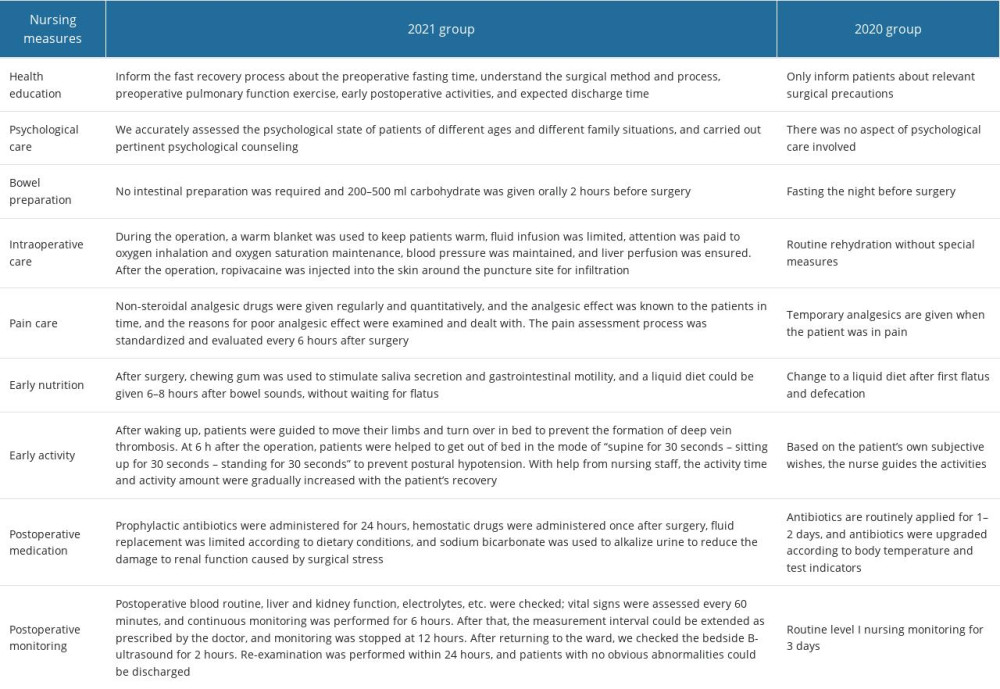 Table 2. Comparison of postoperative recovery.
Table 2. Comparison of postoperative recovery.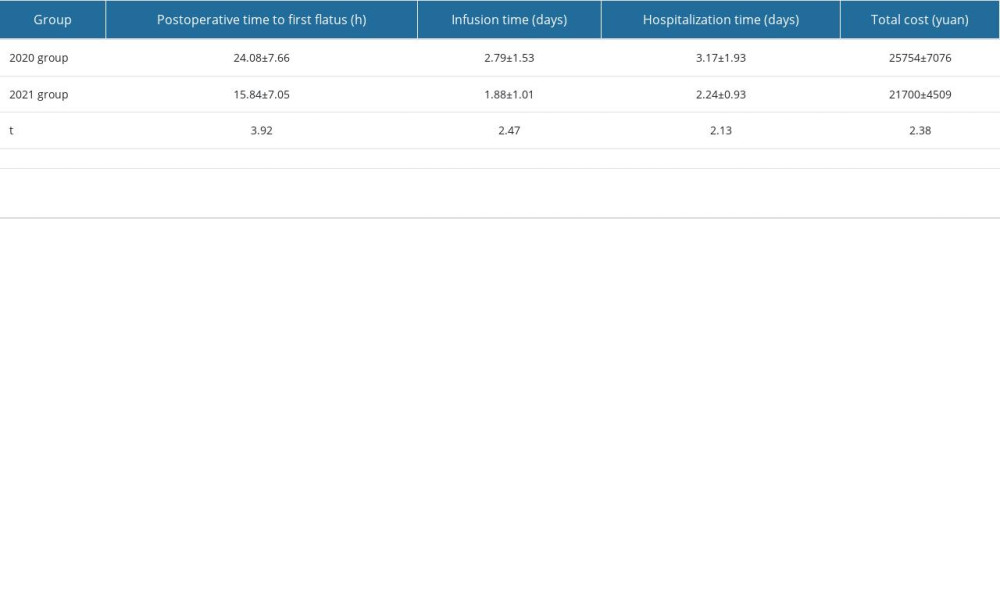 Table 3. Comparison of postoperative pain scores.
Table 3. Comparison of postoperative pain scores.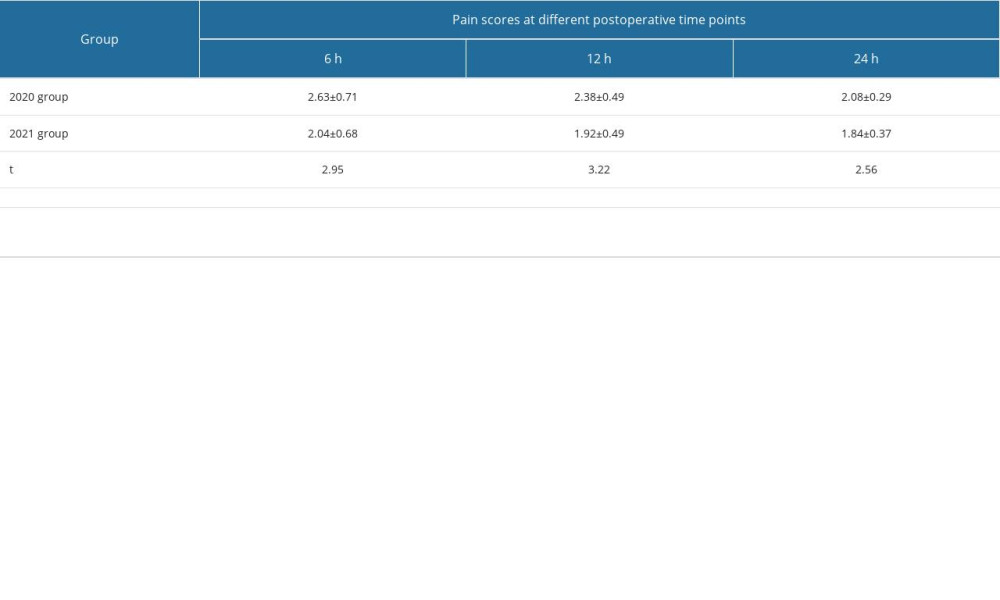 Table 4. Comparison of postoperative complications.
Table 4. Comparison of postoperative complications.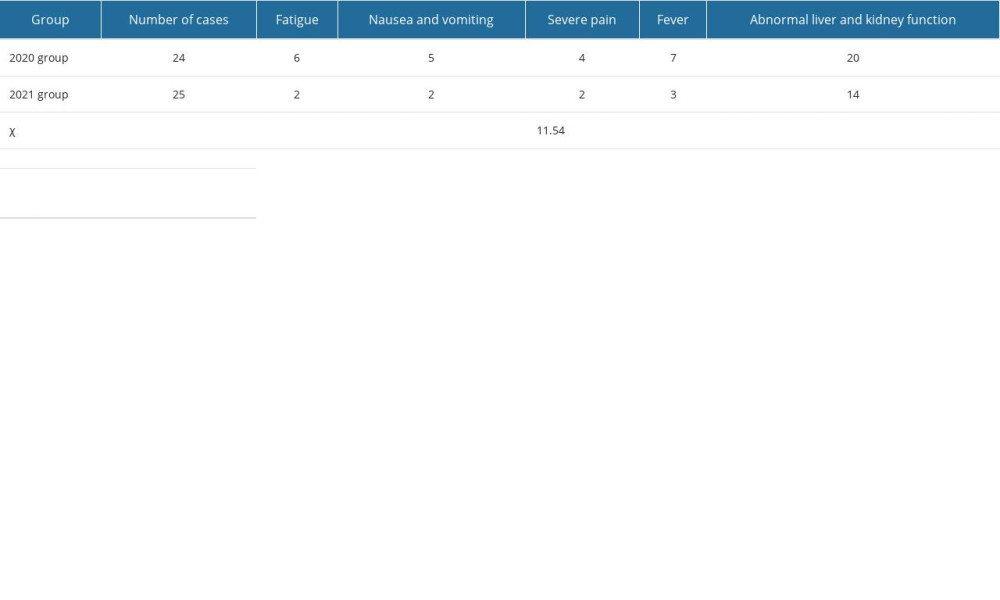 Table 5. Comparison of postoperative liver and kidney function indicators.
Table 5. Comparison of postoperative liver and kidney function indicators.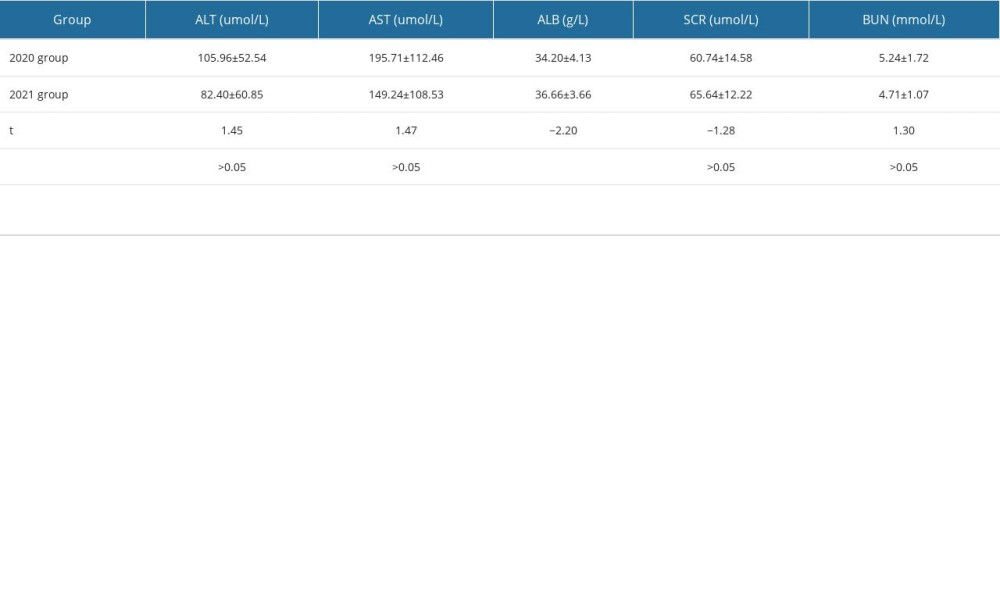 Table 6. Comparison of patient satisfaction scale.
Table 6. Comparison of patient satisfaction scale.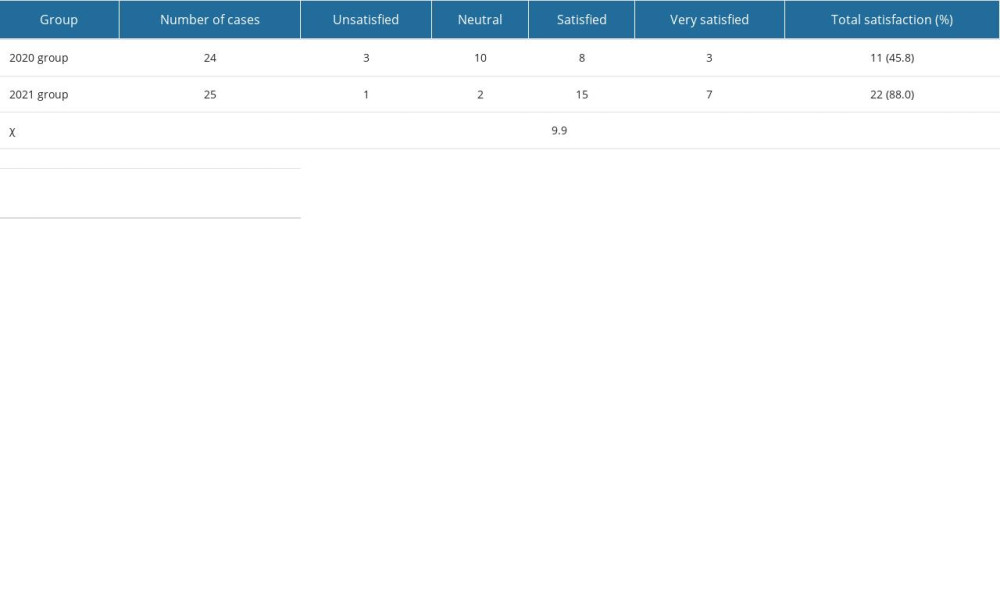
References
1. Wilmore DW, Kehlet H, Management of patients in fast-track surgery: BMJ, 2001; 322(7284); 473-76
2. Nanavati AJ, Prabhakar S, A Comparative study of fast track versus traditional care protocols in gastrointestinal surgery: J Gastrointes Surg, 2014; 18; 757-67
3. Bray F, Ferlay J, Soerjomataram I, Global Cancer Statistics 2020: GLOBOCAN Estimates of Incidence and Mortality Worldwide for 36 Cancers in 185 Countries: CA Cancer J Clin 05, 2021; 71(3), doi: 10.3322/caac.21660
4. Crocetti L, de Baere T, Lencioni R, Quality improvement guidelines for radiofrequency ablation of liver tumours: Cardiovasc Intervent Radiol, 2010; 33(1); 11-17
5. Van Amerongen MJ, Jenniskens SFM, Van den Boezem PB, Radiofrequency ablation compared to surgical resection for curative treatment of patients with colorectal liver metastases – a meta-analysis: HPB (Oxford), 2017; 19(9); 749-56
6. Zhou J, He X, Wang M, Enhanced recovery after surgery in patients with hepatocellular carcinoma undergoing laparoscopic hepatectomy: Front Surg, 2021; 8; 764887
7. Jiang W, Mao Q, Xie Y, Enhanced recovery after surgery (ERAS) program in elderly patients undergoing laparoscopic hepatectomy: A retrospective cohort study: Transl Cancer Res, 2020; 9(8); 4563-72
8. Ljungqvist O, Scott M, Fearon KC, Enhanced recovery after surgery: A review: JAMA Surg, 2017; 152(3); 292-98
9. Neville A, Lee L, Antonescu I, Systematic review of outcomes used to evaluate enhanced recovery after surgery: Br J Surg, 2014; 101(3); 159-70
10. Ljungqvist O, Scott M, Fearon KC, Enhanced recovery after surgery: A review: JAMA Surgery, 2017; 152(3); 292
11. Lee DH, Lee JM, Lee JY, Radiofrequency ablation of hepatocellular carcinoma as firstline treatment: Long-term results and prognostic factors in 162 patients with cirrhosis: Radiology, 2014; 270; 900-9
12. Choi JW, Park EC, Kim TH, Mental disorders and suicide risk among cancer patients: A nationwide cohort study: Arch Suicide Res, 2022; 26(1); 44-55
13. Gustafsson UO, Oppelstrup H, Thorell A, Adherence to the ERAS-protocol is associated with 5-year survival after colorectal cancer surgery: A retrospective cohort study: World J Surg, 2016; 40(7); 1741-47
14. Gylvin SH, Jørgensen CC, Fink-Jensen A, Psychiatric disease as a risk factor in fast-track hip and knee replacement: Acta Orthop, 2016; 87(5); 439-43
15. Greco M, Capretti G, Beretta L, Enhanced recovery program in colorectal surgery: A meta-analysis of randomized controlled trials: World J Surg, 2014; 38(6); 1531-41
16. Futatsuki T, Yamashita A, Ikbar KN, Involvement of orexin neurons in fasting- and central adenosine-induced hypothermia: Sci Rep, 2018; 8(1); 2717
17. Gwynne-Jones DP, Martin G, Crane C, Enhanced recovery after surgery for hip and knee replacements: Orthop Nurs, 2017; 36(3); 203-10
18. Huang J, Cao C, Nelson G, A review of enhanced recovery after surgery principles used for scheduled caesarean delivery: J Obstet Gynaecol Can, 2019; 41(12); 1775-88
19. Luo J, Zhou L, Lin S, Beneficial effect of fluid warming in elderly patients with bladder cancer undergoing Da Vinci robotic-assisted laparoscopic radical cystectomy: Clinics (Sao Paulo), 2020; 75; e1639
20. Wainwright TW, Gill M, Mcdonald DA, Consensus statement for perioperative care in total hip replacement and total knee replacement surgery: Enhanced Recovery After Surgery (ERAS) Society recommendations: Acta Orthopaedica, 2020; 91(1); 3-19
21. Zhu X, Wu D, Sang L, Comparative effectiveness of glucosamine, chondroitin, acetaminophen or celecoxib for the treatment of knee and/or hip osteoarthritis: a network meta-analysis: Clin Exp Rheumatol, 2018; 36(4); 595-602
22. Barney EZ, Pedro CD, Gamez BH, Ropivacaine and ketorolac wound infusion for post-cesarean delivery analgesia: A randomized controlled trial: Obstet Gynecol 02, 2020; 135(2); 427-35
23. Mak HW, Schneider S, Individual differences in momentary pain-affect coupling and their associations with mental health in patients with chronic pain: J Psychosom Res, 2020; 138; 110227
24. Costa RB, Dos Santos ER, Lopes CT, Adequacy of the activities in the nursing intervention exercise therapy: Ambulation for medical-surgical patients with impaired physical mobility: Int J Nurs Knowl, 2016; 27(4); 201-4
25. Barbieux J, Hamy A, Talbot MF, Does enhanced recovery reduce postoperative ileus after colorectal surgery?: J Visc Surg, 2017; 154(2); 79-85
26. Di Iorio BR, Bellasi A, Raphael KL, Treatment of metabolic acidosis with sodium bicarbonate delays progression of chronic kidney disease: The UBI Study: J Nephrol, 2019; 32(6); 989-1001
27. Jones EL, Wainwright TW, Foster JD, A systematic review of patient reported outcomes and patient experience in enhanced recovery after orthopaedic surgery: Ann R Coil Surg Engl, 2014; 96(2); 89-94
28. Song W, Wang K, Zhang RJ, The Enhanced Recovery After Surgery (ERAS) program in liver surgery: A meta-analysis of randomized controlled trials: Springerplus, 2016; 5; 207
29. Paton F, Chambers D, Wilson P, Effectiveness and implementation of enhanced recovery after surgery programmes: A rapid evidence synthesis: BMJ Open, 2014; 4; e005015
Tables
 Table 1. Comparison of nursing measures between the 2 groups.
Table 1. Comparison of nursing measures between the 2 groups. Table 2. Comparison of postoperative recovery.
Table 2. Comparison of postoperative recovery. Table 3. Comparison of postoperative pain scores.
Table 3. Comparison of postoperative pain scores. Table 4. Comparison of postoperative complications.
Table 4. Comparison of postoperative complications. Table 5. Comparison of postoperative liver and kidney function indicators.
Table 5. Comparison of postoperative liver and kidney function indicators. Table 6. Comparison of patient satisfaction scale.
Table 6. Comparison of patient satisfaction scale. In Press
07 Mar 2024 : Clinical Research
Knowledge of and Attitudes Toward Clinical Trials: A Questionnaire-Based Study of 179 Male Third- and Fourt...Med Sci Monit In Press; DOI: 10.12659/MSM.943468
08 Mar 2024 : Animal Research
Modification of Experimental Model of Necrotizing Enterocolitis (NEC) in Rat Pups by Single Exposure to Hyp...Med Sci Monit In Press; DOI: 10.12659/MSM.943443
18 Apr 2024 : Clinical Research
Comparative Analysis of Open and Closed Sphincterotomy for the Treatment of Chronic Anal Fissure: Safety an...Med Sci Monit In Press; DOI: 10.12659/MSM.944127
08 Mar 2024 : Laboratory Research
Evaluation of Retentive Strength of 50 Endodontically-Treated Single-Rooted Mandibular Second Premolars Res...Med Sci Monit In Press; DOI: 10.12659/MSM.944110
Most Viewed Current Articles
17 Jan 2024 : Review article
Vaccination Guidelines for Pregnant Women: Addressing COVID-19 and the Omicron VariantDOI :10.12659/MSM.942799
Med Sci Monit 2024; 30:e942799
14 Dec 2022 : Clinical Research
Prevalence and Variability of Allergen-Specific Immunoglobulin E in Patients with Elevated Tryptase LevelsDOI :10.12659/MSM.937990
Med Sci Monit 2022; 28:e937990
16 May 2023 : Clinical Research
Electrophysiological Testing for an Auditory Processing Disorder and Reading Performance in 54 School Stude...DOI :10.12659/MSM.940387
Med Sci Monit 2023; 29:e940387
01 Jan 2022 : Editorial
Editorial: Current Status of Oral Antiviral Drug Treatments for SARS-CoV-2 Infection in Non-Hospitalized Pa...DOI :10.12659/MSM.935952
Med Sci Monit 2022; 28:e935952








